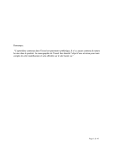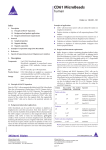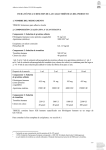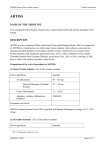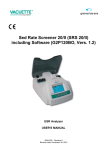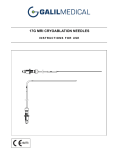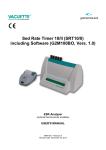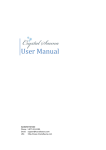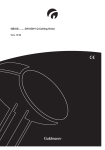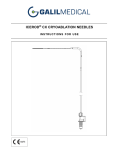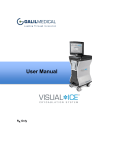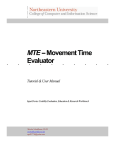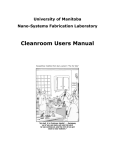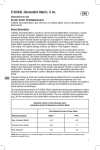Download (Human), Vapor Heated, Solvent/Detergent Treated 500 IU
Transcript
PRODUCT MONOGRAPH Pr TISSEEL Fibrin Sealant (Human), Vapor Heated, Solvent/Detergent Treated 500 IU (Fast Set) in two presentation forms: - Kit: Lyophilized Powders with Diluents for Topical Application, - Frozen: Solutions for Thawing for Topical Application, Hemostatic Agent Baxter Corporation Mississauga, ON Canada L5N 0C2 Submission Control No: 183459 Date of Revision: March 31, 2015 Date of Approval: June 19, 2015 Page 1 of 41 Table of Contents 1. PART I: HEALTH PROFESSIONAL INFORMATION .................................................... 3 SUMMARY PRODUCT INFORMATION ............................................................................... 3 DESCRIPTION .......................................................................................................................... 3 INDICATIONS AND CLINICAL USE ..................................................................................... 4 CONTRAINDICATIONS .......................................................................................................... 5 WARNINGS AND PRECAUTIONS ......................................................................................... 6 ADVERSE REACTIONS......................................................................................................... 10 DRUG INTERACTIONS ......................................................................................................... 13 DOSAGE AND ADMINISTRATION ..................................................................................... 14 OVERDOSAGE ....................................................................................................................... 25 ACTION AND CLINICAL PHARMACOLOGY ................................................................... 26 STORAGE AND STABILITY ................................................................................................. 26 DOSAGE FORMS, COMPOSITION AND PACKAGING .................................................... 27 ACCESSORIES ........................................................................................................................ 29 2. PART II: SCIENTIFIC INFORMATION .......................................................................... 30 PHARMACEUTICAL INFORMATION................................................................................. 30 CLINICAL TRIALS ................................................................................................................. 32 DETAILED PHARMACOLOGY ............................................................................................ 34 TOXICOLOGY ........................................................................................................................ 37 3. PART III: CONSUMER INFORMATION......................................................................... 39 PATIENT COUNSELLING INFORMATION ........................................................................ 39 Page 2 of 41 TISSEEL Fibrin Sealant (Human), Vapor Heated, Solvent/Detergent Treated, 500 IU/mL 1. PART I: HEALTH PROFESSIONAL INFORMATION SUMMARY PRODUCT INFORMATION Route of Administration Topical Dosage Form / Strength Clinically Relevant Nonmedicinal Ingredients 500 IU (Fast Set) - TISSEEL -Lyophilized Powders with Diluents: 2.0 mL, 4.0 mL, 10.0 mL (total volume) or For a complete listing see Dosage Forms, Composition and Packaging Section. - Frozen Solutions for Thawing: 2.0 mL, 4.0 mL, 10.0 mL (total volume) DESCRIPTION TISSEEL (Fibrin Sealant (Human), Vapor Heated, Solvent/Detergent Treated) is a twocomponent fibrin sealant made from pooled human plasma. When combined, the two components, Sealer Protein (Human) and Thrombin (Human), mimic the final stage of the blood coagulation cascade. TISSEEL is intended only for topical administration. Sealer Protein (Human) Sealer Protein (Human) is a sterile, non-pyrogenic, vapor-heated and solvent/detergent treated preparation made from pooled human plasma. Sealer Protein (Human) is provided either as a freeze-dried powder Sealer Protein Concentrate (Human) for reconstitution with Synthetic Aprotinin Solution or as a finished frozen liquid Sealer Protein-Aprotinin Solution pre-filled into one side of a double-chamber syringe (chamber containing Sealer Protein -Aprotinin Solution is marked as “1”). The active ingredient in Sealer Protein (Human) component is fibrinogen. In addition Factor XIII is co-purified with clottable protein from human plasma. No Factor XIII is added to the Sealer Protein (Human) manufacturing process, resulting in a Factor XIII level of 0.6-10 U/mL in the drug product. A Fibrinolysis Inhibitor, Aprotinin is included in the Sealer Protein (Human) component to preclude premature fibrinolysis. To obtain Sealer Protein Concentrate Page 3 of 41 (Human), cryoprecipitate derived from the plasma is dissolved in buffer solution, solvent/detergent treated, purified by precipitation and washing steps, vapor heat treated, formulated, sterile filtered and either freeze-dried in vials or concentrated under vacuum and frozen in pre-filled syringes. Thrombin (Human) Thrombin (Human) is a sterile, non-pyrogenic, vapor-heated and solvent/detergent treated preparation made from pooled human plasma. Thrombin (Human) is also provided either as a freeze-dried powder for reconstitution with Calcium Chloride Solution or as a finished frozen liquid Thrombin-Calcium Chloride Solution pre-filled into one side of a double-chamber syringe (chamber containing Thrombin-Calcium Chloride solution is marked as “2”). The active ingredient human Thrombin is prepared from plasma through a series of separation and filtration steps followed by incubation of the solution with calcium chloride to activate prothrombin to thrombin. The solution subsequently undergoes ultra/diafiltration, vapor heat treatment, solvent/detergent treatment, purification by ion exchange chromatography, formulation, sterile filtration and either freeze-drying in vials or filling and freezing in pre-filled syringes. The setting rate of the Fibrin Sealant depends on the concentration of the human Thrombin as contained in the Thrombin-Calcium Chloride Solution used. The TISSEEL thrombin component is provided in a 500 IU/mL concentration (TISSEEL 500 IU, Fast Set). Time to clot formation/polymerisation commences within seconds with a Thrombin concentration of 500 IU/mL. Therefore, TISSEEL 500 IU (Fast Set) is indicated to be used to achieve rapid setting, e.g. for hemostasis. Sealer Protein (Human) and Thrombin (Human) are made from pooled human plasma. The vapor heat and solvent/detergent treatment steps used in the manufacturing process have been shown to be capable of significant viral reduction. Despite this, when medicinal products prepared from human blood or plasma are administered, the possibility of transmitting infective agents cannot be totally excluded (see WARNINGS AND PRECAUTIONS and PHARMACEUTICAL INFORMATION, and see DOSAGE FORMS, COMPOSITION AND PACKAGING for available package sizes and presentations). INDICATIONS AND CLINICAL USE TISSEEL (Fibrin Sealant (Human), Vapor Heated, Solvent Detergent Treated) is used in addition to standard measures, to achieve hemostasis, to seal or glue tissue, and to support wound healing. Indications include: abdominal surgery2, 6, 7 cardiovascular surgery4, 5, 8, 9 orthopedic surgery1, 10 thoracic surgery11, 12, 13 urology3, 14, 15, 16 Page 4 of 41 Geriatrics (> 65 years of age): Efficacy and safety in use of Fibrin Sealant has been evaluated in a clinical trial involving a number of geriatric patients. No overall differences in safety or effectiveness were observed between these subjects and younger subjects. Pediatrics (1.1 – 16 years of age) or (< 16 years of age): Efficacy and safety in use of Fibrin Sealant has been evaluated in a clinical trial involving also a group of pediatric patients and was not found to be different from an adult population. CONTRAINDICATIONS Patients who are hypersensitive to this drug or to any ingredient in the formulation or component of the container. For a complete listing, see the DOSAGE FORMS, COMPOSITION AND PACKAGING Section of the product monograph. TISSEEL should not be used in individuals with a known hypersensitivity to Aprotinin. TISSEEL is contraindicated for intravascular application. Intravascular application may result in life threatening thromboembolic events. For the treatment of massive and brisk arterial or venous bleeding, TISSEEL alone is not effective and not indicated for this treatment. Page 5 of 41 WARNINGS AND PRECAUTIONS Serious Warnings and Precautions Intravascular application of TISSEEL can lead to intravascular coagulation, may result in lifethreatening thromboembolic events and might increase the likelihood and severity of acute hypersensitivity reactions in susceptible patients. Especially in coronary bypass surgery, TISSEEL should be applied with caution to minimize any risk of intravascular application. However, if in well-founded cases the injection of TISSEEL and/or Thrombin Solution/s into a tissue or vessel is proposed, careful risk/benefit analysis of the individual case is required. As with any other protein products, hypersensitivity or allergic/anaphylactic/anaphylactoid reactions may occur with the use of TISSEEL, a fibrin sealant that contains aprotinin. In isolated cases, these reactions have progressed to severe anaphylaxis. Aprotinin, a monomeric polypeptide, is known to be associated with anaphylactic reactions. These reactions may also occur in patients receiving Aprotinin or TISSEEL for the first time or even if first application was well tolerated, but generally risk may be increased if the preparation is applied repeatedly over time or in the same setting. Manifestations of hypersensitivity reactions to TISSEEL observed include: flush, urticaria, pruritus, nausea, drop in blood pressure, tachycardia or bradycardia, dyspnea, severe hypotension, bronchospasm, wheezing, angioedema, erythema, paresthesia. Fatal anaphylactic reactions, including anaphylactic shock, have also been reported with TISSEEL (see ADVERSE REACTIONS). As with other aprotinin-containing products, the use of TISSEEL should be documented in the patient’s records, pointing out that TISSEEL contains aprotinin. In the event of hypersensitivity reactions, administration of TISSEEL is to be discontinued. Remove any applied, polymerized product from the surgical site. Mild reactions can be managed with antihistamines. Severe hypotensive reactions require immediate intervention using current principles of shock therapy. Adequate medical treatment and provisions should be available for immediate use in the event of an anaphylactic reaction. Caution must be used when applying fibrin sealant using pressurized air or gas (See DOSAGE AND ADMINISTRATION). Life-threatening/fatal air or gas embolism has occurred with the use of spray devices employing a pressure regulator to administer TISSEEL. This event appears to be related to the use of the spray device at higher than recommended pressures and in close proximity to the tissue surface. The risk appears to be higher when fibrin sealants are sprayed with air, as compared to CO2, and therefore cannot be excluded when TISSEEL is used in open wound surgery. Solutions containing alcohol, iodine or heavy metals will interfere with the product’s performance due to denaturation of proteins or other mechanisms. Page 6 of 41 General Fibrin Sealant is made from human plasma. Products made from human plasma may contain infectious agents, such as viruses, that can cause disease. This also applies to unknown or emerging viruses and other pathogens. The risk that such products will transmit an infectious agent has been reduced by screening plasma and by inactivating and removing certain viruses. Despite these measures, there may still carry a risk of transmitting infectious agents, e.g., viruses, and theoretically, the Creutzfeldt-Jakob disease (CJD) agent. The standard measures taken (including double virus inactivation by vapor heat treatment and solvent detergent treatment) are considered effective for enveloped viruses such as HIV, HBV, and HCV, and for the non-enveloped virus HAV. Some viruses, such as parvovirus B19, are particularly difficult to remove or inactivate at this time. Parvovirus B19 most seriously affects pregnant women (fetal infection) and individuals with immunodeficiency or increased red blood cell turnover. In the submucous injection of fibrin sealant into hollow organs to stop GI-bleeding (stomach, duodenum), the following points are to be considered: • Insertion of the needle into the organ wall may result in accidental perforation, which in rare cases may injure adjoining organs or vessels. • Injection into the submucous membrane may cause a mechanical dissection between the tunica mucosa and the tunica muscularis propria, which in rare cases may lead to vessel injury or the formation of an intramural hematoma. • Injection into the nasal mucosa must be avoided, as severe allergic-anaphylactoid reactions have been seen and thromboembolic events may occur. This product must not be used in animals. The user is cautioned against the spray application of TISSEEL with devices produced by other manufacturers. Only use application devices licensed for the administration of TISSEEL. TISSEEL with the EasySpray Set must not be used in enclosed body areas. When spraying TISSEEL, changes in blood pressure, pulse, oxygen saturation and end tidal CO2, should be monitored because of the possibility of occurrence of air or gas embolism. The EASYSPRAY control device, DuploSpray MIS Surgical Sealant Delivery System and the Spray Set may be obtained from Baxter. To prevent TISSEEL from adhering to gloves and instruments, wet these with saline before contact with Sealant. Page 7 of 41 To avoid the formation of excess granulation tissue and to ensure gradual absorption of the solidified fibrin sealant, only a thin layer of TISSEEL should be applied (see Application Precautions and OVERDOSAGE). Immediately before application, expel and discard the first several drops from the application cannula to ensure adequate mixing of the Sealer Protein and Thrombin Solutions. Separate, sequential application of the two components must be avoided. Application Precautions Only a thin layer of TISSEEL should be applied. Excessive thickness of the fibrin sealant layer may interfere with the products efficacy and the wound healing process. It is strongly recommended that every time TISSEEL is applied to a patient, the name and batch number of the product are recorded in order to maintain a link between the patient and the batch of the product. When applying TISSEEL using the EASYSPRAY device, be sure to use the pressure within the pressure range recommended by the spray device manufacturer. Do not spray at a pressure above 2 bar or at a distance closer than 10 cm from the surface of the tissue. When spraying TISSEEL, changes in blood pressure, pulse, oxygen saturation and end tidal CO2 should be monitored because of the possibility of occurrence of air or gas embolism. When applying TISSEEL using the DuploSpray MIS system, connect to regulated CO2 gas source only; maximum input pressure not to exceed 100 psi. To avoid possible gas embolism, do not directly spray into circulatory pathways. Any application of pressurized gas may be associated with a potential risk of gas embolus, tissue rupture or gas entrapment with compression, which may be life threatening. Be sure to take appropriate measures to address these risks by observing the maximum spray pressure of 1.5 bar, the recommended minimum spraying distance of 2 cm (optional working distance 3 cm) and the maximal flow rate of 2.0 standard liters per minute. For use by or on order of a licensed physician. To reduce the risk of a potentially life-threatening gas embolism, when applying TISSEEL using a spray device be sure to use a pressure and a distance from tissue with the ranges recommended by the manufacturer in the following table. TISSEEL spray application should only be used if it is possible to accurately judge the spray distance. Page 8 of 41 Recommended pressure, distance and devices for spray application of TISSEEL Applicator Pressure Recommended Spray set to be Surgery tips to be regulator to distance from used used be used target tissue Tisseel/Artiss n.a EasySpray Spray Set Pressure Regulator Open wound 10-15 cm Tisseel/Artiss n.a EasySpray Spray set 10 pack Pressure Regulator Laparoscopic/ minimally invasive procedures n.a DuploSpray MIS Applicator 20 cm DuploSpray MIS Applicator 30 cm DuploSpray MIS Applicator 40 cm Replaceable Tip Recommended Spray Pressure 1.5-2.0 bar (21.5-28.5 psi) DuploSpray MIS Regulator DuploSpray MIS Regulator DuploSpray MIS Regulator 2-5 cm 1.2-1.5 bar (18-22 psi) DuploSpray MIS Regulator Solutions containing alcohol, iodine or heavy metals will interfere with the product’s performance due to denaturation of proteins or other mechanisms. If any of these substances have been used to clean the wound area, the area must be thoroughly rinsed before application of TISSEEL. Cardiovascular In coronary bypass surgery, TISSEEL should be applied with caution to minimize any risk of intravascular application. Sexual Function/Reproduction Animal reproduction studies have not been conducted with TISSEEL. It is also not known whether it can affect reproduction capacity. Page 9 of 41 Special Populations Pregnant Women: No experience. Animal reproduction studies have not been conducted with TISSEEL. It is also not known whether it can cause fetal harm when administered to a pregnant woman. Healthcare providers should balance the potential risks and only prescribe TISSEEL if clearly needed. See WARNING AND PRECAUTIONS for information on Parvovirus B19 infection. Nursing Women: It is not known whether this drug is excreted in human milk. Because many drugs are excreted in human milk, caution should be exercised when TISSEEL is administered to a lactating woman. Healthcare providers should balance the potential risks and only prescribe TISSEEL if clearly needed. Neurosurgical Procedures The safety and effectiveness of TISSEEL used alone or in combination with biocompatible carriers in neurosurgical procedures or other surgeries involving confined spaces have not been evaluated. If fibrin sealants are applied in confined spaces, the risk of compressive complications should be taken into account. ADVERSE REACTIONS Adverse Drug Reaction Overview Allergic and/or anaphylactic reactions may occur in patients with a history of hypersensitivity to Aprotinin. Such reactions may be seen in the event of repeated administration, even if the first application was well tolerated. However, allergic and/or anaphylactic reactions may also occur in patients receiving TISSEEL for the first time. If symptoms require treatment to be initiated, this should be effected in the usual manner, as for instance with antihistamines, corticoids or adrenalin. No adverse events of this type were reported during the clinical trials for TISSEEL. Clinical Trial Adverse Drug Reactions (ADRs) Because clinical trials are conducted under widely varying conditions, adverse reaction rates observed in the clinical trials may not reflect the rates observed in practice. Page 10 of 41 TISSEEL 500 IU (Fast Set): The following ADRs have been reported from three clinical trials. None of the events was classified as serious. During a clinical study in cardiovascular surgery where 157 patients were treated with TISSEEL 500 IU (Fast Set) two cases of increased Fibrin D-Dimer levels were observed, but did not exceed values reported in the literature occurring after this type of surgery. Postoperatively increased D-Dimers may result at least partly from the degradation of Fibrin Sealant (see Part II Clinical Trials, trial number 550003). In a study in axillary lymph node dissection where 79 patients were treated with TISSEEL 500 IU (Fast Set), the most frequently occurring ADRs were seroma (13 cases) and pain in limb (4 cases). However, the overall incidence of (related and unrelated) seroma and procedural pain was comparable between the TISSEEL 500 IU (Fast Set) and an untreated control group (21.5% vs. 18.3%) in this study. Other adverse events reported were: 2 cases each of nausea, postoperative wound infection and post-procedural pain, and 1 case each of pain, increase of body temperature, increase of fibrin degradation products, sensory disturbance, rash, axillary vein thrombosis and hypotension. No adverse events related to TISSEEL 500 IU (Fast Set) were reported from a study in hip joint replacement from the 53 patients treated with the product. The related adverse events of the cardiovascular surgery study and the lymph node dissection study are listed according to their system organ class in the table below. Frequencies are based on patients treated in the respective studies because the indications of the two studies were too different to pool the data. Page 11 of 41 System Organ Class Adverse events (Preferred Term) Blood and lymphatic system disorders Fibrin D-Dimer increased Nervous system disorders Gastrointestinal disorders Skin and subcutaneous tissue disorders Musculoskeletal and connective tissue disorders Infections and infestations Injury, poisoning and procedural complications Vascular disorders General disorders and administration site conditions Increase of Fibrin degradation products Sensory disturbance Nausea TISSEEL 500 IU Number of events/Number of patients treated 2 of 157 1 of 79 1 of 79 2 of 79 Rash 1 of 79 Pain in extremity 4 of 79 Postoperative wound infection 2 of 79 Seroma 13 of 79 Axillary vein thrombosis Hypotension 1 of 79 1 of 79 Procedural Pain 2 of 79 Pain Body temperature increased 1 of 79 1 of 79 Post-Market Adverse Drug Reactions The adverse reactions listed below reflect what has been reported in post-marketing experience with Baxter Fibrin Sealants: Immune system disorders: Anaphylactic responses, hypersensitivity (manifestations include bradycardia, tachycardia, hypotension, flushing, bronchospasm, wheezing, dyspnea, nausea, urticaria, angioedema, pruritus, erythema, paresthesia; anaphylactic reactions, including anaphylactic shock, have included fatal outcomes) Cardiac disorders: Bradycardia, tachycardia Vascular disorders: Hypotension, Hematoma, embolism arterial, including cerebral artery embolism, cerebral infarction*, air embolism** * as a result of intravascular application into the superior petrosal sinus ** as with other fibrin sealants, life-threatening/fatal air or gas embolism has occurred when using devices with pressurized air or gas; this event appears to be related to an inappropriate use of the spray device (e.g., at higher than recommended pressure and in close proximity to the tissue surface) Page 12 of 41 Respiratory, thoracic and mediastinal disorders: Dyspnea Gastrointestinal disorders: Nausea, intestinal obstruction Skin and subcutaneous tissue disorders: Urticaria General disorders and administration site conditions: Flushing, impaired healing, oedema, pyrexia Injury, poisoning and procedural complication: Seroma There have been rare reports of serious adverse events such as paralysis and other compressive complications possibly related to the use of fibrin sealant in combination with resorbable hemostatic agents. Manifestations of hypersensitivity or allergic reactions include application site irritation, chest discomfort, chills, headache, lethargy, restlessness, and vomiting. There have also been rare reports of fatalities following the misadministration of topical thrombin. Because these reactions are reported voluntarily and the population is of uncertain size, it is not always possible to reliably estimate the frequency of these reactions. DRUG INTERACTIONS Overview No formal interaction studies have been performed. 1 Drug interactions are not known. TISSEEL (Fibrin Sealant (Human), Vapor Heated, Solvent/Detergent Treated) can even be applied in fully heparinised patients (e.g. extracorporeal circulation). Incompatibilities Solutions containing alcohol, iodine or heavy metals will interfere with the product’s performance due to denaturation of proteins or other mechanisms. If any of these substances have been used to clean the wound area, the area must be thoroughly rinsed before application of 1 None known based upon the absence of data from clinical trials, current medical/scientific literature, and safety reports. Page 13 of 41 TISSEEL. Oxidized cellulose-containing preparations may reduce the efficacy of TISSEEL by inactivating thrombin and should not be used as carrier materials. TISSEEL must not be mixed with other medicinal products. DOSAGE AND ADMINISTRATION TISSEEL 500 IU (Fast Set) (Fibrin Sealant (Human), Vapor Heated, Solvent/Detergent Treated) is available in two different dosage forms: Kit and Frozen. TISSEEL Kit consists of 2 vials containing powder preparations of Sealer Protein Concentrate and Thrombin and two vials containing liquid preparations of Aprotinin and Calcium Chloride. The Sealer Protein Concentrate is reconstituted with the Aprotinin and produces a solution that is referred to as the Sealer Protein-Aprotinin Solution. Thrombin is reconstituted with the Calcium Chloride Solution, which produces a solution that is referred to as the Thrombin-Calcium Chloride Solution. These two solutions are applied using an application device described in the DOSAGE AND ADMINISTRATION, Method of Application section. TISSEEL Kit is available in 2, 4 and 10 mL pack sizes (1, 2 and 5 mL reconstituted Sealer Protein Solution and 1, 2 and 5 mL reconstituted Thrombin Solution). TISSEEL Frozen consists of a pre-filled double-chamber syringe containing Sealer ProteinAprotinin Solution and Thrombin-Calcium Chloride Solution. TISSEEL Frozen is available in 2, 4 and 10 mL pack sizes. Dosing Considerations For topical use only – do not inject. Dry the site of application. Prior to applying TISSEEL the surface area of the wound needs to be dried by standard techniques (e.g. intermittent application of compresses, swabs, use of suction devices). Do not use pressurized air or gas for drying the site. Recommended Dose and Dosage Adjustment Dosage of TISSEEL, i.e., the amount applied, is individualized based on the application area and purpose of use. Only a thin layer of TISSEEL should be applied. Excessive thickness of the fibrin layer may interfere with the product’s efficacy and the wound healing process. The application can be repeated, if necessary. However, avoid re-application to a pre-existing polymerized TISSEEL layer, as TISSEEL may not adhere firmly to a polymerized layer. If used for tissue adherence, it is recommended that the initial application cover the entire Page 14 of 41 intended application area. The amount of TISSEEL to be applied depends on the size of the surface to be covered. The approximate surface areas covered by each package size of TISSEEL are listed in the following table: Area to be sealed (cannula, catheter) Area to be sealed using compressed gas (spray application) Required package size of TISSEEL 8 cm2 16 cm2 40 cm2 25-100 cm2 50-200 cm2 125-500 cm2 2 mL 4 mL 10 mL Administration Various methods can be used to simultaneously apply the two components of TISSEEL: a) b) c) d) using application cannula contained in DUPLOJECT System / DUO Set using Spray Set and EASYSPRAY using DUPLOCATH Application Catheters or other accessories provided by Baxter using DUPLOSPRAY MIS regulator, applicator and tips 1. Preparation of TISSEEL Kit (Freeze-Dried) The following instructions are for the reconstitution of TISSEEL Kit using the DUPLOJECT System provided within the Kit. However, an equivalent device can also be used. For operation instructions please refer to the Instructions for Use provided together with this device. Check for appropriate component colour-coding before reconstitution of the component. Prior to reconstitution of TISSEEL the rubber stoppers of all vials should be cleansed. After reconstitution, the product must be used within 4 hours. Reconstituted solutions must not be refrigerated or frozen. Vials are for single use only. Note: Do not use the syringes and needles previously used for reconstitution of one component for the reconstitution of the other component to prevent premature setting. Direct contact between disinfectant and product must be avoided (See DRUG INTERACTIONS). Page 15 of 41 a) How to Prepare TISSEEL Sealer Protein Solution Freeze-dried Sealer Protein Concentrate is reconstituted in the Aprotinin Solution of 3,000 KIU/mL using the FIBRINOTHERM warming and stirring device (recommended method). Alternatively, a sterile water bath at a temperature of 33°C to 37°C can be used. i) Reconstitution of Freeze-Dried Sealer Protein Concentrate Using FIBRINOTHERM device: For ease of handling, a combined heating and stirring device, FIBRINOTHERM, has been developed to meet the specific requirements of reconstituting freeze-dried Sealer Protein Concentrate. FIBRINOTHERM is a thermoblock with a magnetic stirrer (the vials for freezedried Sealer Protein Concentrate contain a magnetic spin propeller to stir the contents). Heating and stirring can be operated independently. In a first step, FIBRINOTHERM heats up to 37°C and then maintains that temperature constantly with minimum variation. The signal light will turn on and off as FIBRINOTHERM is maintaining its temperature. FIBRINOTHERM has been designed to hold the various vial sizes of freeze-dried Sealer Protein Concentrate and Aprotinin Solution. - - - - After plugging the FIBRINOTHERM into an electrical socket and activating the warmer using the amber switch, place the Sealer Protein Concentrate and Aprotinin Solution vials from the TISSEEL Kit into prewarmed warming wells with the appropriate sized adaptor ring. Refrigerated product may take up to 5 minutes to warm. Room temperature product will take less time. Transfer Aprotinin Solution into vial containing freeze-dried Sealer Protein Concentrate using blue-scaled syringe of corresponding size (or syringe that has been used for dilution of Aprotinin Solution). Note: Only combine preheated Aprotinin Solution with preheated Sealer Protein Concentrate. Place vial into largest opening of FIBRINOTHERM (if necessary, use adaptors). Turn on stirrer with flip switch and stir contents for 8 – 10 minutes. Reconstitution of freeze-dried Sealer Protein Concentrate is complete as soon as no undissolved particles are detectable in transparent light. Otherwise, replace into FIBRINOTHERM and agitate for another few minutes until the solution appears homogeneous. Note: Excessive stirring (20 minutes or more) may compromise product quality. Note: Keep the Sealer Protein Solution at 37°C or at room temperature without stirring if it is not to be used immediately. Before use the solution should be warmed to 37°C. To ensure homogeneity, stir or swirl briefly before aseptically drawing up the Sealer Protein Solution into the blue-scaled syringe provided in DUPLOJECT System. ii) Reconstitution of Freeze-Dried Sealer Protein Concentrate Using a Water Bath: Note: When using a water bath for reconstitution, special precautions must be taken against submerging the vial, particularly the septum, to avoid possible contamination. Page 16 of 41 Preheat the vials containing the Sealer Protein Concentrate (lyophilized) and the Aprotinin Solution for approximately 3 minutes in a water bath at a temperature of 33°C to 37°C. (Heating beyond 37°C must be avoided!) Remove the flip-off caps from the vial containing freeze-dried Sealer Protein Concentrate and the vial containing Aprotinin Solution, disinfect the rubber stoppers of both vials with a germicidal solution and allow to dry. Do not use iodine-containing preparations such as betadine for disinfection. Transfer Aprotinin Solution into vial containing freeze-dried Sealer Protein Concentrate using blue-scaled syringe of corresponding size (or syringe that has been used for dilution of Aprotinin Solution). Allow vial to stand at 37°C for one minute. Swirl briefly and vigorously with a circular motion (avoid excessive frothing) and replace vial into water-bath for another 10 – 15 minutes. Reconstitution of freeze-dried Sealer Protein Concentrate is complete as soon as no undissolved particles are detectable in transparent light. Otherwise, swirl again briefly and keep vial at 37°C for a few more minutes. Draw up Sealer Protein Solution into a sterile blue-scaled syringe using aseptic precautions (insert a needle through the rubber stopper at its center to allow access of air). Note: If not used immediately, keep Sealer Protein Solution at 37°C or at room temperature without stirring if it is not to be used immediately. Before use the solution should be warmed to 37°C. The maximum holding time of 4 hours upon reconstitution must not be exceeded. To ensure homogeneity, swirl with a circular motion (avoid frothing) before drawing up the solution. - b) How to Prepare Thrombin Solution Remove the flip-off caps from the vial containing Thrombin and the vial containing Calcium Chloride Solution, disinfect the rubber stoppers of both vials with a germicidal solution and allow to dry. Do not use iodine-containing preparations such as betadine for disinfection. Transfer the contents of the vial with Calcium Chloride Solution into the vial containing the freeze-dried Thrombin using the sterile reconstitution components provided with the DUPLOJECT System. Swirl briefly. Place the vial into the adapted opening of the FIBRINOTHERM device or Water Bath. Reconstitution of Thrombin is complete when all of the Thrombin concentrate is dissolved. Keep the Thrombin Solution at 37°C or at room temperature without stirring if it is not to be used immediately. Before use the solution should be warmed to 37°C. c) Transferring to the Sterile Field For transfer of the Sealer Protein Solution and the Thrombin Solution to the sterile field, the scrub nurse should withdraw the solutions while the circulating nurse holds the non-sterile vials. The solutions should be withdrawn slowly by firm constant aspiration to reduce the risk of large air bubbles. Page 17 of 41 2. Preparation of TISSEEL Frozen (in pre-filled syringes) Do not use TISSEEL unless it is completely thawed and warmed (liquid consistency). Do not remove the protective syringe cap until thawing is complete and application tip is ready to be attached. Room Temperature Thawing Approximate thawing times when using this method are: Pack Size (In Pouches) 2 mL 4 mL 10 mL Thawing Time at Room Temperature 60 minutes 110 minutes 160 minutes Unopened pouches of TISSEEL 500 IU (Fast Set), thawed at room temperature, may be stored for up to 7 days at room temperature (15°C -25°C) after removal from the freezer. Prior to use, the product should be warmed to 33°C to 37°C. TISSEEL in pre-filled syringe (frozen) may be thawed under controlled conditions using one of the three following options: Option 1 – Thawing on the sterile field using a Sterile Water Bath: 33°C to 37°C sterile water bath - transfer double-chamber syringe set and the inner pouch to the sterile field, remove the double-chamber syringe with pre-filled syringes from inner pouch and place directly into sterile water bath. Ensure the double-chamber syringe is completely immersed under the water. Approximate thawing and warming times when using this method are: Pack Size 2 mL 4 mL 10 mL Thawing/Warming Times 33°C to 37°C Sterile Water Bath (Pouches Removed) 5 minutes 5 minutes 12 minutes Option 2 – Thawing off the sterile field using a Water Bath: 33°C to 37°C non-sterile water bath, double-chamber syringe in two pouches - maintain the double-chamber syringe set in both pouches and place into a water bath off the sterile field for appropriate time. Ensure the pouches remain submerged throughout thawing. Remove from the Page 18 of 41 water bath after thawing, dry external pouch and transfer inner pouch and pre-filled syringes onto the sterile field. Approximate thawing and warming times when using this method are: Pack Size 2 mL 4 mL 10 mL Thawing/Warming Times 33°C to 37°C Non-Sterile Water Bath (In Pouches) 30 minutes 40 minutes 80 minutes Option 3 – Thawing off the sterile field using an Incubator: Incubator (33°C to 37°C) in pouches – maintain the -pre-filled syringe in both pouches and place into an incubator for appropriate time. Remove from incubator after thawing and transfer inner pouch and pre-filled syringes onto the sterile field. Approximate thawing and warming times when using this method are: Pack Size 2 mL 4 mL 10 mL Thawing/Warming Times 33°C to 37°C Incubator (In Pouches) 40 minutes 85 minutes 105 minutes NOTE: After thawing, the product must not be refrigerated, refrozen or be exposed to temperatures above 37oC. Keep the product at 33°C - 37oC until needed. The product must be used within 12 hours after warming to 33°C - 37oC or removal from original pouches. 3. Method of Application Application Considerations See WARNINGS AND PRECAUTIONS, General and Application Precautions. The use of TISSEEL is restricted to experienced surgeons who have been trained in the use of TISSEEL. Page 19 of 41 In open wound surgery, the EasySpray pressure regulator that delivers a maximum pressure of no more than 2.0 bar (28.5 psi) should be used. Avoid spraying closer than 10 cm from the surface of the tissue. In minimally invasive/laparoscopic procedures, use the DuploSpray pressure regulator that delivers a maximum pressure of no more than 1.5 bar (22 psi) using only carbon dioxide (CO2) gas. Observe the recommended minimum spraying distance of 2 cm. TISSEEL should only be reconstituted and administered according to the instructions and with the devices recommended for this product (see WARNINGS AND PRECAUTIONS, General). Regarding spray applications, see WARNINGS AND PRECAUTIONS, Application Precautions for specific recommendations on the required pressure and distance from tissue per surgical procedure and length of applicator tips. The setting rate depends on the concentration of the human Thrombin as contained in the Thrombin-Calcium Chloride solution used. The TISSEEL Thrombin component is provided in a 500 IU/mL concentration (TISSEEL 500 IU, Fast Set). A 4 IU/mL Thrombin concentration is also available and marketed as ARTISS 4 IU, Slow Set. Prior to application, TISSEEL must be warmed to 33°C to 37°C. TISSEEL must not be exposed to temperatures above 37°C and must not be microwaved. The sealer protein and the thrombin solutions should be clear or slightly opalescent. Do not use solutions that are cloudy or have deposits. Inspect products for particulate matter and discoloration prior to application. Before application of TISSEEL, ensure that parts of the body outside the desired application area are sufficiently covered to prevent tissue adhesion at undesired sites. - - - - - Prior to applying TISSEEL the surface area of the wound needs to be dried by standard techniques (e.g. intermittent application of compresses, swabs, use of suction devices). Apply TISSEEL as a thin layer. The initial amount of the product to be applied should be sufficient to entirely cover the intended application area. If TISSEEL does not fully adhere to tissue and bleeding continues, remove TISSEEL clot and repeat application. Ensure that the two components are quickly and thoroughly mixed, which is essential for TISSEEL to gain the optimum strength. The Spray Set is particularly suitable for spraying of larger areas. In operation sites where access is difficult or when using an endoscope or trocar, TISSEEL can be applied using DUPLOCATH Application Catheters or DuploSpray MIS Surgical Sealant Delivery System. With the use of TISSEEL, 500 IU/mL, the clotting process commences within seconds. After TISSEEL has been applied, allow at least 2 minutes to achieve sufficient Page 20 of 41 - polymerization. Once turbid, TISSEEL can no longer be manipulated. Solidified Sealant reaches its ultimate strength after about two hours (70% after about ten minutes). a) Simultaneous Application using application cannula contained in DUPLOJECT System or DUO Set: i) Administration using DUPLOJECT System - - For application, clip the two single-use syringes with the reconstituted Sealer Protein Solution and Thrombin Solution into the DUPLOJECT Two-Syringe Clip and connect this assembly to a joining piece and an application cannula. The common plunger of the DUPLOJECT Two-Syringe Clip ensures that equal volumes are fed through the joining piece, before being mixed in the application cannula and ejected. Operating Instructions: - - - Place the two syringes filled with Sealer Protein Solution and with Thrombin Solution into the clip. Both syringes should be filled with equal volumes. Connect the nozzles of the two syringes to the joining piece ensuring that they are firmly fixed. Secure the joining piece by fastening the tether strap to the DUPLOJECT TwoSyringe Clip. Should the pull strap tear, use the spare joining piece. If none is available, further use is still possible but tightness of the connection needs to be ensured to prevent any risk of leaking. Fit an application cannula onto the joining piece. Page 21 of 41 - - Do not expel the air remaining inside the joining piece or application cannula until you start actual application as the aperture of the cannula may clog otherwise. Apply the mixed Sealer Protein - Thrombin Solution onto the recipient surface or surfaces of the parts to be sealed. If application of the fibrin sealant components is interrupted, clogging may occur in the cannula. To resume application, replace the application cannula with a new one. If the apertures of the joining piece are clogged, use the spare joining piece provided in the DUPLOJECT System. Note: For operation instructions please refer to the Instructions for Use provided together with the DUPLOJECT System. ii) Administration using DUO Set - For application, the double-chamber syringe with the Sealer Protein Solution and the Thrombin Solution has to be connected to a joining piece and an application cannula. Operating Instructions: - - Remove the cap covering the nozzles of the double-chamber syringe. Connect the nozzles of the double-chamber syringe to the joining piece ensuring that they are firmly fixed. Secure the joining piece by fastening the tether strap to the doublechamber syringe. Should the pull strap tear, use the spare joining piece. If none is available, further use is still possible but tightness of the connection needs to be ensured to prevent any risk of leaking. Fit an application cannula onto the joining piece. Fit the double plunger to the end of the syringe chamber. Page 22 of 41 - - Do not expel the air remaining inside the joining piece or application cannula until you start actual application as the aperture of the cannula may clog otherwise Apply the mixed Sealer Protein - Thrombin Solution onto the recipient surface or surfaces of the parts to be sealed If application of the fibrin sealant components is interrupted, clogging may occur in the cannula. To resume application, replace the application cannula with a new one. If the apertures of the joining piece are clogged, use the spare joining piece provided in the Duo Set. b) Simultaneous Application Using Spray Set and EASYSPRAY: Caution must be used when applying fibrin sealant using pressurized air or gas. • Any application of pressurized air or gas is associated with a potential risk of air embolism, tissue rupture, or gas entrapment with compression, which may be life-threatening. • TISSEEL must be sprayed only onto application sites that are visible. Spray Set and EASYSPRAY can be connected to TISSEEL Kit (see drawing below) and TISSEEL Frozen in the same way. Note: For operation instructions please refer to the Instructions for Use provided together with Spray Set and Easy Spray. Page 23 of 41 The Spray Set is particularly suitable for spraying of larger areas, e.g. to control oozing of parenchymatous organs or to adhere skin grafts. The two components are sprayed simultaneously using sterile propellant gas via EASYSPRAY, and the volume of the Solutions ejected is controlled with the DUPLOJECT System / DUO Set plunger. The user must follow the instructions and precautions in the Spray Set and EASYSPRAY device user manual, for example regarding the need to limit the gas pressure to a maximum of 2 bars. Spray at a minimum distance of 10 cm. Only use application devices licensed for the administration of TISSEEL. c) Simultaneous Application Using DUPLOCATH Application Catheters or other accessories provided by Baxter: In operation sites where access is difficult or when using an endoscope or trocar, TISSEEL can be applied using DUPLOCATH Application Catheters. Note: For operation instructions please refer to the Instructions for Use provided together with DUPLOCATH Application Catheter 25, 35 or 180. In case of using other accessories provided by Baxter, please refer to the operating instructions contained in the Instructions for Use for the particular accessory. d) Simultaneous Application by Premixing: Mix equal volumes of the two components and immediately apply them to the recipient surface or surfaces. If desired, the Thrombin Solution can be mixed with spongiosa to pack bone defects. Hold in place for three minutes. Once turbid, TISSEEL can no longer be manipulated. e) Simultaneous Application Using DuploSpray MIS Surgical Sealant Delivery System The DuploSpray MIS applicator is intended for the application of TISSEEL Fibrin Sealant. The applicator consists of a rigid and sterile stainless steel cannula, dual lumen spray tubing, sterile filter, and two replacement spray tips. It delivers a thin, uniform film of fibrin sealant over wound surfaces for maximum product utilization and broad area coverage. The regulator is a pressure-regulating device for the control and release of compressed gas from a pressurized CO2 source; this is the safest gas to use in laparoscopic procedures, and with a patient vent line, provides pressure stability during application. The gas-assisted applicator mixes and disperses the combined TISSEEL components for application of a thin layer to an open or shallow treatment site. The spray output is adjustable from a coarse to fine droplet size and a foot switch activates the gas flow. When using the DuploSpray MIS spray device (for minimally invasive surgery) it should not be sprayed closer than 2 cm. Page 24 of 41 A diagram of the DUPLOSPRAY MIS REGULATOR is provided below: Note: For operation instructions please refer to the Instructions for Use provided together with DuploSpray MIS Applicator and DuploSpray MIS Regulator. Gluing of Tissue After the two components have been applied, approximate the wound areas. Fix or hold the glued parts in the desired position for three to five minutes to ensure that the setting Sealant adheres firmly to the surrounding tissue. Solidified Sealant reaches its ultimate strength after about two hours (70% after about ten minutes). OVERDOSAGE No symptoms of overdose are known for TISSEEL. As the product is actively used by the surgeon, overdose is very unlikely to occur. TISSEEL is only to be used by a physician in a hospital setting. Only a thin layer of TISSEEL should be applied to avoid the formation of excess granulation tissue and to ensure gradual absorption of the polymerized fibrin sealant. Excessive thickness of the fibrin layer may negatively interfere with the product’s efficacy and the wound healing process (See DOSAGE AND ADMINISTRATION and WARNINGS AND PRECAUTIONS). Page 25 of 41 ACTION AND CLINICAL PHARMACOLOGY Mechanism of Action TISSEEL (Fibrin Sealant (Human), Vapor Heated, Solvent/Detergent Treated) is a tissue glue with sealing, hemostyptic and gluing properties, which does not interfere with but may enhance wound healing. The action of TISSEEL simulates key features of the physiological process of wound closure. A highly concentrated fibrinogen Aprotinin solution, which among other ingredients contains Factor XIII co-fractionated from the plasma, and a solution of thrombin and calcium chloride are applied to the wound area, where the mixture coagulates. The presence of Factor XIII causes the fibrin to crosslink, which gives the coagulum additional resilience. Aprotinin prevents premature degradation of the clot. Pharmacodynamics Thrombin is a highly specific protease that transforms the fibrinogen contained in Sealer Protein (Human) into fibrin. Part of the thrombin is adsorbed by the fibrin, and any excess thrombin is inactivated by protease inhibitors in the blood. Fibrinolysis Inhibitor, Aprotinin, is a polyvalent protease inhibitor that prevents premature degradation of fibrin. Free Aprotinin has a half-life (t ½) of approx. 0.82 and is eliminated by the kidney. Preclinical studies with different fibrin sealant preparations simulating the fibrinolytic activity generated by extracorporeal circulation in patients during cardiovascular surgery have shown that incorporation of Aprotinin in the product formulation increases resistance of the fibrin sealant clot to degradation in a fibrinolytic environment. Pharmacokinetics TISSEEL is intended for local application only, therefore systemic exposure or distribution to other organs or tissues is not expected and pharmacokinetic studies were not conducted. STORAGE AND STABILITY TISSEEL Kit (Freeze-Dried) When stored between 2°C and 25°C (36°F and 77°F), TISSEEL (Fibrin Sealant (Human), Vapor Heated, Solvent/Detergent Treated) Kit, lyophilized, is stable until the expiry date indicated on the label. Do not freeze. After reconstitution, the product must be used within 4 hours. Reconstituted solutions must not be refrigerated or frozen. Page 26 of 41 TISSEEL Pre-filled Syringe (Frozen) When stored at ≤ -20°C (≤ -4°F), TISSEEL (Fibrin Sealant (Human), Vapor Heated, Solvent/Detergent Treated) Frozen, in pre-filled syringes, is stable until the expiry date indicated on the label. Room Temperature Storage: Unopened pouches, thawed at room temperature, may be stored for up to 7 days at room temperature (15°C -25°C) after removal from the freezer. DOSAGE FORMS, COMPOSITION AND PACKAGING Dosage Forms and Packaging TISSEEL (Fibrin Sealant (Human), Vapor Heated, Solvent/Detergent Treated) is available in two different dosage forms: Kit and Frozen. Strength 500 IU/mL Volume (Total) 2 mL 4 mL 10 mL Kit Frozen One vial lyophilized Sealer Protein (Human) Concentrate, to be reconstituted with one vial 1.0 mL/ 2.0 mL/ 5.0 ml of Aprotinin Solution, sterile 1.0 mL/ 2.0 mL/ 5.0 mL of sterile frozen TISSEEL Sealer Protein (Human)-Aprotinin Solution One vial lyophilized Thrombin (Human) 500 IU, to be reconstituted with one vial 1.0 mL/ 2.0 mL/ 5.0 mL of Calcium Chloride Solution, sterile 1.0 mL/ 2.0 mL/ 5.0 mL of sterile frozen Thrombin (Human) – Calcium Chloride Solution Page 27 of 41 TISSEEL Kit also contains DUPLOJECT System, the Kit for Reconstitution and Application consisting of 4 transfer needles, 2 blue-scaled syringes, 2 black-scaled syringes, 1 DUPLOJECT two-syringe clip, 2 joining pieces and 4 application cannulas. TISSEEL Frozen also contains DUO Set, the sterile accessory devices consisting of 1 plunger, 2 joining pieces and 4 application cannulas. See the following Accessories Section for more accessories for use with TISSEEL. Composition TISSEEL 500 IU Kit consists of 4 separate vials containing Sealer Protein (Human), Aprotinin Solution, Thrombin (Human) and Calcium Chloride Solution. TISSEEL 500 IU Frozen consists of a double-chamber syringe containing Sealer ProteinAprotinin Solution (syringe body 1) and Thrombin-Calcium Chloride Solution (syringe body 2). After reconstituting the vials in the Kit, the resulting concentrations of the Sealer ProteinAprotinin solution and the Thrombin-Calcium Chloride solution are the same as those in the Frozen presentation. 1 2 Component Amount Sealer Protein (Human)-Aprotinin Solution, sterile, contains: - Total protein 96-125 mg/mL - Factor XIII 0.6-10 U/mL** - Fibrinogen (Clottable Protein) 72-110 mg/mL - Plasmafibronectin (CIG)* 2-9 mg/mL - Plasminogen* 40 – 120 µg/mL - Aprotinin Solution, sterile 3,000 KIU/mL*** Thrombin (Human)-Calcium Chloride Solution, sterile, contains: - Thrombin (Human) 400 - 625 IU/mL**** - Calcium Chloride Solution, sterile 36 - 44 μmol/mL * Development data, not tested at the Final Product level ** One unit corresponds to the amount of Factor XIII contained in 1 mL of fresh normal plasma. *** 30 Kallidinogenase Inactivator Units (KIU) correspond to 1 FIP-Unit18. **** One International Unit (IU) of Thrombin is defined as the activity contained in 0.0853 mg of the First International Standard of Human Thrombin19. Nonmedicinal ingredients in the Sealer Protein-Aprotinin solution are human albumin, niacinamide and water for injection (WFI). Nonmedicinal ingredients in the Thrombin-Calcium Chloride solution are human albumin, sodium chloride and water for injection (WFI). Sodium Hydroxide and Hydrochloric Acid are used to adjust the pH in both solutions. All plasma units used for manufacture are ALT tested and non-reactive in tests for Hbs-antigen and antibodies to HCV, HIV-1 and HIV-2. Before further processing all individual plasma Page 28 of 41 donations are subjected to an inventory hold for a possible look-back of plasma donations suspected of infection. All plasma units are tested by HIQ-PCR = Hyland Immuno Quality Assured Polymerase Chain Reaction. ACCESSORIES The following are some accessories for use with TISSEEL VH S/D. A complete list of accessories can be obtained from a Baxter representative. When using these devices, strictly follow the Instructions for Use of the devices. FIBRINOTHERM EASYSPRAY Spray Set (sterile, disposable) DUPLOCATH 25 Application Catheter DUPLOCATH 35 M.I.S Application Catheter DUPLOCATH 180 Application Catheter DUPLOSPRAY MIS SURGICAL SEALANT DELIVERY SYSTEM DuploTip Dual Lumen Cannula Combined Heating and Stirring Device Propellant gas control unit, manometer, reducing valve, and pressure tube. Disposable set consisting of sterile filter with connection tube, sensing line and a spray head. Length: approximately 25 cm (10”) Diameter: approximately 5 french (approx. 0.17 cm) Radiopaque. Sterile. Disposable. Catheter: Length: approximately 35 cm (14”) Diameter: approximately 5 french (approx. 0.17 cm) Adapter: Length: approximately 30 cm (12”) Diameter: 15 french (0.5 cm) For insertion through a 5-6 mm trocar in minimally invasive surgery (M.I.S.) Radiopaque. Sterile. Disposable. Length: approximately 180 cm (70”) Diameter: approximately 5 french (approx. 0.17 cm) For use with an endoscope. The Application Catheter 180 can be shortened to any length necessary. Radiopaque. Sterile. Disposable. Propellant gas control unit with 20 cm, 30 cm and 40 cm applicators and tips for the application of surgical sealant. Catheter double canal Length: 10.4 cm or 32 cm Alternative reconstitution accessories are available for TISSEEL. Page 29 of 41 2. PART II: SCIENTIFIC INFORMATION PHARMACEUTICAL INFORMATION Drug Substance See PART I – DESCRIPTION and PART II – DETAILED PHARMACOLOGY Sections. Product Characteristics See PART I – DESCRIPTION and PART II – DETAILED PHARMACOLOGY Sections. Viral Inactivation TISSEEL (Fibrin Sealant (Human), Vapor Heated, Solvent/Detergent Treated) is made from human plasma. Products made from human plasma may contain infectious agents, such as viruses, that can cause disease. The risk that such products will transmit an infectious agent has been reduced by screening plasma donors for prior exposure to certain viruses (see Detailed Pharmacology), by testing for the presence of certain current virus infections, and by inactivating and removing certain viruses in the course of the manufacture. The manufacturing procedure for TISSEEL includes processing steps designed to further reduce the risk of viral transmission. In particular, vapor heating and solvent/detergent treatment processes are included in the manufacturing of Sealer Protein Concentrate and Thrombin. In addition the reduction factors as associated with DEAE-Sephadex Batch Chromatography and Ion Exchange Chromatography of the Thrombin drug substance purification were investigated. Validation studies were conducted using samples drawn from manufacturing intermediates for each of the two human plasma derived components. These samples were spiked with stock virus suspensions of known titers followed by further processing under conditions equivalent to those in the respective manufacturing steps. The virus reduction factors (expressed as log10) of independent manufacturing steps were as follows for each of the viruses tested: Page 30 of 41 Reduction Factors for Virus Removal and/or Inactivation Sealer Protein Component Mean Reduction Factors [log10] of Virus Tested* Manufacturing Step Early Manufacturing Steps Solvent/Detergent Treatment Vapor Heat Treatment Overall Reduction Factor (ORF) HIV-1 HAV BVDV PRV n.d. n.d. n.d. n.d. >5.3 >5.5 >10.8 n.d. >5.6 >5.6 >5.7 >5.7 >11.4 >5.9 >6.7 >12.6 MMV B19V 2.7** 3.4** 2.3** n.d. n.d. 1.2 1.0 3.5 3.3 Reduction Factors for Virus Removal and/or Inactivation Thrombin Component Mean Reduction Factors [log10] of Virus Tested* Manufacturing Step HIV-1 HAV BVDV PRV MMV B19V Removal of Thrombin precursor 3.2 1.5 1.8 2.5 1.2 1.7 protein from Cryosupernatant Vapor Heat Treatment >5.5 >4.9 >5.3 >6.7 1.0 >4 Solvent/Detergent Treatment >5.3 n.d. >5.5 >6.4 n.d. n.d. Ion Exchange Chromatography n.d. n.d. n.d. n.d. 3.6 n.d. Overall Reduction Factor (ORF) >14.0 >6.4 >12.6 >15.6 5.8 >5.7 n.d. = not determined * The mean RF of all runs was calculated. E.g. when two runs were performed in study A and one run in study B for HIV-1, then the mean of the three RF’s was calculated and listed in the table. ** As a conservative value for general and robust Parvovirus reduction capacity in steps 1 to 8, 2.3 logs were calculated from MMV and B19V reduction factors (omitting the higher B19V reduction factor). For calculation of and rationale behind this value, see further above in the section where the corresponding study is discussed. For calculation of virus-specific overall reduction factors, however, only virus-specific individual reduction factors were considered. HIV-1: Human immunodeficiency virus 1; HAV: Hepatitis A virus; BVDV: Bovine viral diarrhea virus, a model for Hepatitis C virus; PRV: Pseudorabies virus, a model for enveloped DNA viruses, among those Hepatitis B virus; MMV: Mice minute virus, a model for Human Parvovirus B19, B19V: Human Parvovirus B19. Page 31 of 41 CLINICAL TRIALS Numerous clinical studies investigating the safety and efficacy of the product as a hemostyptic and biodegradable tissue glue in various fields of surgery have been performed. A number of these were controlled studies in fields including orthopedic surgery, abdominal surgery, urology, and cardiovascular surgery. The cardiovascular safety study using the heat treated product has shown that TISSEEL (Fibrin Sealant (Human), Vapor Heated, Solvent/Detergent Treated) transmits neither hepatitis viruses nor HIV. Pre-clinical studies have shown that the vapor treated product is at least as effective as the heat treated product. In the clinical study 550003 described below, TISSEEL was shown to be non-inferior to an earlier formulation of the product, TISSEEL VH (predecessor product) and both products were shown not to transmit hepatitis, HIV or P19B. Use of TISSEEL has invariably shown superior results in the groups treated as against the untreated controls who underwent the same types of surgery. These results were attributable to an improved hemostasis and, therefore, reduced blood loss, a tighter sealing of sutures preventing leakages or a fast and uncomplicated healing of the surgical wound. In none of the studies have systemic side-effects been seen nor has any product related transmission of viral hepatitis or HIV occurred in any of the patients treated. TISSEEL 500 IU (Fast Set): TISSEEL 500 IU was evaluated in a prospective, parallel design, randomized (1:1), doubleblind, multicenter clinical study (550003) against an earlier formulation of the product, TISSEEL VH, in 317 subjects undergoing cardiac surgery requiring cardiopulmonary bypass (CPB) and median sternotomy. Patients were treated with TISSEEL 500 IU or the control product only when hemostasis was not achieved by conventional surgical methods. For the endpoint, hemostasis achieved at the primary treatment site within 5 minutes of treatment and maintained until closure of the surgical wound, TISSEEL 500 IU was at least as effective as the earlier formulation of the product using a one-sided 97.5% confidence interval on the difference in the proportion of subjects successfully treated. Hemostasis within 5 minutes and maintained until surgical closure TISSEEL 500 IU Predecessor product TISSEEL VH Intent to Treat Analysis 127/144 (88.2%) 129/144 (89.6%) Per Protocol Analysis 108/123 (87.8%) 122/135 (90.4%) Page 32 of 41 Geriatrics (> 65 years of age): In this Phase 3 clinical study of TISSEEL 500 IU, 71 of 144 subjects were 65 and over. No overall differences in safety or effectiveness were observed between these subjects and younger subjects, and other reported clinical experience has not identified differences in responses between the elderly and younger patients. An earlier formulation of TISSEEL’s predecessor product, TISSEEL HT (heat treated, containing bovine thrombin) was evaluated in an open-label crossover study against control topical hemostatic agents in 489 patients undergoing cardiovascular reoperation or resternotomy at 11 institutions. Patients were randomized to TISSEEL HT or control hemostatic agents when a topical hemostatic was needed at the conclusion of surgery and after all attempts at surgical hemostasis. Patients were crossed to the alternative therapy if bleeding continued after the 5 minute endpoint. At 10 centres, TISSEEL HT was used after administration of protamine sulfate. At one site, TISSEEL HT could be used before administration of protamine sulfate. 365 of the 489 patients developed bleeding episodes requiring treatment. In these patients, for the endpoint, successful hemostasis at 5 minutes, TISSEEL HT was statistically significantly superior to control topical hemostatic agents. Hemostasis within 5 minutes Predecessor TISSEEL HT Control Topical Hemostatic Agent 82.4% (159/193) 44.5% (76/172) Pearson χ two sided; p <0.0001; intent-to-treat analysis 2 Similarly, absolute time to cessation of bleeding was statistically significantly shorter for TISSEEL HT than for control topical hemostatic agents (p<0.0001, Wilcoxon-Gehan test, two sided). In a single center, open label trial, an earlier formulation of TISSEEL HT was compared to historical controls in patients undergoing laparotomy for blunt or penetrating traumatic injury to the spleen and/or liver. Use of TISSEEL HT resulted in the need for statistically significantly fewer splenectomies than control hemostatic maneuvers: Injury to: Spleen Spleen and liver Splenectomy Rate Predecessor Historic Controls TISSEEL HT 0/19 14/22 1/26 19/34 p <0.001 p <0.001 TISSEEL HT did not result in significantly reduced mortality in patients with blunt or penetrating trauma to the liver alone or to the liver and spleen (p=0.067, χ2, one sided). In a single center, prospective open label study of 120 patients randomized to standard of care (59 patients) or standard of care plus fibrin sealant (61 patients) for elective colostomy closure after temporary colostomy placement for treatment of traumatic injury to the colon, the earlier Page 33 of 41 version of TISSEEL HT plus standard of care was also shown to be significantly superior to standard of care alone (p=0.0406, Jonckheere-Terpstra test for ordinal data, two sided) with regard to anastomotic complications (leakage, intra-abdominal abscess formation, re-operation, septic shock, and death). DETAILED PHARMACOLOGY The substances in the TISSEEL (Fibrin Sealant (Human), Vapor Heated, Solvent/Detergent Treated) Kit are used to prepare two components: Sealer Protein Solution and Thrombin Solution. Sealer Protein Solution is produced by dissolving Sealer Protein Concentrate in Aprotinin Solution. Freeze-dried Thrombin, dissolved in Calcium Chloride Solution, yields the Thrombin Solution. The assembly for TISSEEL Frozen is reflecting the composition of the Kit components after reconstitution, filled in a double-chamber syringe, which is stored in a deep frozen condition: Sealer Protein Concentrate-Aprotinin (syringe chamber 1) and Thrombin-Calcium Chloride Solution (syringe chamber 2). Sealer Protein Concentrate (Human) Aprotinin Solution (Synthetic) Sealer ProteinAprotinin Solution TISSEEL Fibrin Sealant Thrombin (Human) Calcium Chloride Solution Thrombin-Calcium Chloride Solution The two components are mixed either immediately before application to the recipient surface or in situ using one of the methods described under Method of Application. The Sealer Protein / Thrombin Solution, after mixing, is a viscous solution adhering to wound surfaces and quickly sets to form a white, rubberlike mass, which continues to gain in strength within two hours following application. This process is made use of to achieve hemostasis, and to seal or glue tissue. In this manner, the need for sutures may be reduced, although not totally eliminated. The time until Sealant sets can be used to approximate wound edges, to provide optimum conditions for healing. In the course of wound healing, Sealant is completely absorbed. Page 34 of 41 Fibrin Sealant is a two-component biological sealant produced from pooled human plasma. As for all plasma products, the following measures are implemented to ensure the safety of the product from the potential presence of pathogenic viruses in human plasma: • Donor selection • Donation testing of single donations and also at the mini-pool and manufacturing pool level • The use of PCR assay system (PCR) for release of plasma pools • Effective virus inactivation/removal steps integrated into the manufacturing process including validation Each plasma donation is tested for infectious markers for human immunodeficiency virus, types 1 and 2 (HIV-1/-2), hepatitis C virus (HCV) and hepatitis B surface antigen (HbsAg). The criteria for release of each single plasma donation for further manufacturing are as follows: • • • HIV-1 / HIV-2 antibody: HbsAg: HCV antibody: non-reactive non-reactive non-reactive Each manufacturing plasma pool is tested and released for further manufacturing only when • • non-reactive for Human Immunodeficiency Virus (HIV), Hepatitis C Virus (HCV), Hepatitis A Virus (HAV) and Hepatitis B Virus (HBV) using Nucleic Acid Testing (NAT) Parvovirus B19 concentration not exceeding 104 IU / mL as measured by NAT Plasma pool are tested using HIQ-PCR = Hyland Immuno Quality Assured Polymerase Chain Reaction. With the PCR method, in general 500 genome equivalents/mL of the above viruses can be determined reliably, with the actual sensitivity of HIQ-PCR being below that. Therefore all pools which have been tested and evaluated as being positive lead to exclusion from further processing. The plasma safety precautions and virus inactivation/removal steps taken during the manufacture of TISSEEL VH S/D 500 IU are equivalent to those used for ARTISS 4 IU. During the pivotal clinical study of TISSEEL VH S/D 500 IU Fibrin Sealant there were zero confirmed seroconversions for HAV, HBV, HCV, HIV or B19V (Baxter clinical study 550003). Although viral safety was not an endpoint in the other clinical studies, any issues concerning viral safety would have been detected and followed up in the process of AE reporting. No reports concerning viral transmission from any studies, involving Fibrin Sealant 4 IU (ARTISS) or 500 IU (TISSEEL) were received. Page 35 of 41 The therapeutic activities of TISSEEL are hemostasis, gluing and sealing of tissue, and the support of wound healing. Physiologically, the process of wound closure starts when a bleeding ceases. In places where injured blood vessels lie open, hemostatic plugs form of platelets and fibrin, which become more and more solid as other blood cells, particularly erythrocytes, are involved. Because the bleeding ceases, blood that has escaped into the wound bed earlier coagulates. In a next step fibrin in both the coagulated blood and hemostatic plug retracts, plasma is squeezed out, the blood vessels contract, and the wound area becomes smaller. As various cells begin to proliferate into the retracted blood coagula, wound healing sets in. In developing Fibrin Sealant, this principle has at least partly been simulated by applying a highly concentrated fibrinogen solution, which also contains factor XIII as co-fractionated from the plasma, and a solution of thrombin and calcium chloride to the wound area, where the mix coagulates. Since the Sealant does not contain thrombocytes, the clotted fibrin does not appreciably retract. When the mixture is applied, however, the fibrin concentration in the coagulum is the same as or higher than that of a retracted hemostatic plug. To preserve the coagulum until the wound healing has reached a stage where it is no longer required, the Sealant has been designed to contain a fibrinolysis inhibitor. The fibrin in the Sealant adheres perfectly to the wound edges guaranteeing adequate sealing effect. Similar to the hemostatic plug, wound healing is promoted by the fibrin applied. Combined application of Sealant with a mixture of autologous or homologous spongiosa provides excellent plugging material for bone defects. Using adequate technique, TISSEEL is also an excellent tool in sealing autologous or homologous cartilage and bone. TISSEEL and all of its components have not been observed to affect systemic circulation, respiration, or the central nervous system. This is attributable to both, the fact that only minimal quantities of each single component are applied compared to their use for other indications, and the fact that TISSEEL becomes only locally effective. The mechanism underlying solidification of tissue and persistence of a solidified clot have been investigated in numerous studies. As a biologic material, Fibrin Sealant becomes completely absorbed at a rate which depends both on the fibrinolytic activity of the surrounding tissue and the quantity of Fibrinolysis Inhibitor added. In the course of wound healing the Sealant clot is gradually replaced by ingrowing tissue, Thrombin is inactivated by the physiological protease inhibitors, Calcium Chloride is subjected to the calcium and chloride catabolism of the organism, and Aprotinin and its metabolites are eliminated by the kidney. Page 36 of 41 TOXICOLOGY The local application of TISSEEL (Fibrin Sealant (Human), Vapor Heated, Solvent/Detergent Treated) underlines the importance of histological studies for toxicology data. Accordingly, histologies have been performed on various species in tissues ranging from skin, vessels, nerves, tendons, organ tissue to bone. In vivo toxicology studies indicated no acute toxicity and normal local tolerance reactions of TISSEEL Frozen 2 with bovine or synthetic Aprotinin in rats and rabbits, respectively. Furthermore, no difference between synthetic and bovine Aprotinin for single-dose toxicity after intravenous application could be detected in mice and rats and synthetic Aprotinin was well tolerated in rabbits. No skin sensitizing potential of synthetic Aprotinin was shown in a Guinea Pig Maximization Test. In vitro, no differences were found between TISSEEL 500 IU Frozen with bovine or synthetic Aprotinin and the predecessor product TISSEEL VH 500 IU lyophilized Kit with respect to cellular compatibility, or mutagenicity. Synthetic Aprotinin was non-mutagenic using an Ames test. Cellular compatibility was confirmed in an additional in vitro study comparing both TISSEEL preparations (frozen and lyophilized) and the predecessor product TISSEEL VH (lyophilized) Kit. In summary, presented in vitro and in vivo data support the equivalence of TISSEEL (frozen and lyophilized) with the predecessor product TISSEEL VH (lyophilized Kit). Moreover, it was shown that synthetic Aprotinin has no negative impact on the safety of the Fibrin Sealant. Long-term animal studies to evaluate the carcinogenic potential of TISSEEL or studies to determine the effect of TISSEEL on fertility have not been performed. On the following page the toxicology program is presented. 2 The composition of TISSEEL frozen, thawed, is identical to the composition of the reconstituted TISSEEL freezedried. Page 37 of 41 Toxicology program for Baxter Fibrin Sealants Study Type Route of Administration Species Test Article Single-dose Toxicity s.c. Rat TISSEEL (frozen) Single-dose Toxicity s.c. Rabbit TISSEEL (frozen) Single-dose Toxicity s.c. Rat TISSEEL s-apr (frozen) Single-dose Toxicity s.c. Rabbit TISSEEL s-apr (frozen) Single-dose Toxicity i.v. Mouse Synthetic Aprotinin Single-dose Toxicity i.v. Rat Synthetic Aprotinin Genotoxicity i.v. E.coli TISSEEL (frozen) Genotoxicity i.v. Salmonella typhimurium Synthetic Aprotinin Local Tolerance s.c. spongiosa blocks Rat TISSEEL (frozen)* Local Tolerance s.c. spongiosa blocks Rabbit TISSEEL (frozen)* Local Tolerance s.c. spongiosa blocks Rat TISSEEL s-apr (frozen)* Local Tolerance s.c. spongiosa blocks Rabbit TISSEEL s-apr (frozen)* Local Tolerance i.v., paravenous Rabbit Synthetic Aprotinin Cytotoxicity i.v. Cytotoxicity i.v. Cytotoxicity i.v. Skin Sensitization intradermal, epicutan Human lung fibroblasts Human lung fibroblasts Human lung fibroblasts Guinea pig TISSEEL (frozen) TISSEEL (lyophilized) TISSEEL s-apr (frozen) Synthetic Aprotinin * Local tolerance studies using a subcutaneously implanted spongiosa block model were conducted with fibrin sealants diluted to a Thrombin concentration of 4 IU/mL. Page 38 of 41 3. PART III: CONSUMER INFORMATION PATIENT COUNSELLING INFORMATION Because this product is made from human plasma, the physician should discuss the risks and benefits with the patient. Patient should be encouraged to consult with their physician if symptoms of B19 virus infection appear (fever, drowsiness, chills and runny nose followed about two weeks later by a rash and joint pain). Page 39 of 41 REFERENCES 1. BÖSCH P.: Die Fibrinspongiosaplastik. Wr. Klin. Wschr. 93, Suppl. 124 (1981) 2. SCHEELE J. et al.: Anastomosensicherung am Verdauungstrakt mit Fibrinkleber. In: Nahttechnische Grundlagen, experimentelle Befunde, klinische Erfahrungen. Zlbl. Für Chirurgie 103, 1325–1336 (1978). 3. GASSER G. et al.: Über die Verwendung eines Fibrinklebers bei Prostatektomie: Vorläufige Mitteilung. In: Fibrinogen, Fibrin und Fibrinkleber, F. K. Schattauer Verlag, 271–273 (1980) 4. ROUSOU J., LEVITSKY S., COSGROVE D. et al.: Randomized Clinical Trial of Fibrin Sealant in Patients Undergoing Resternotomy of Reoperation After Cardiac Operations. In: The Journal of Thoracic and Cardiovascular Surgery, Vol. 97, No. 2, 194–203 (1989) 5. WOLNER E.: Fibrin Gluing in Cardiovascular Surgery. Thorac. Cardiovasc. Surg. 30, Georg Thieme Verlag Stuttgart, N. York, 236–237 (1982) 6. MARCZELL A., EFFERDINGER F., SPOULA H., STIERER M.: Anwendungsbereiche des Fibrinklebers in der Abdominalchirurgie. Acta Chir. Austriaca 11, 26. 137–141 (1979) 7. SCHEELE J.: Klinische Erfahrungen mit der Fibrinklebung an parenchymatösen Oberbauchorganen. Akt. Chir. 17 (1982) 8. KALMAR P., KREBBER H. J., POKAR H., TILSNER V.: Bioadhesives in Cardiac and Vascular Surgery. Thorac. Cardiovasc. Surg. 30, 230–231 (1982) 9. HAVERICH A., WALTERBUSCH G., BORST H. G.: The Use of Fibrin Glue for Sealing Vascular Prostheses of High Porosity. Thorac. Cardiovasc. Surg. 29, 252–254 (1981) 10. BÖSCH P., NOWOTNY Ch., SCHWÄGERL W., LEBER H.: Über die Wirkung des Fibrinklebesystems bei orthopädischen Operationen an Hämophilen und bei anderen Blutgerinnungsstörungen. In: Fibrinogen, Fibrin und Fibrinkleber, Kl. Schimpf, F. K. Schattauer Verl., 275–277 (1980) 11. THETTER O.: Fibrin Adhesive and its Application in Thoracic Surgery. Thorac. Cardiovasc. Surg. 29, 290–292 (1981) 12. HARTEL W., LAAS J.: Zusätzliche Abdichtung von Pleura-Läsionen mit Fibrinkleber Klinische Studie (1981) 13. STAINDL O.: Beitrag zur chirurgischen Behandlung gutartiger Trachealstenosen. Wr. Med. Wschr. 128, 175–177 (1978) 14. VECSEY D.: Über eine neue Methode der Blutstillung mit Klebematerial bei der Adenomektomie. Urologie und Nephrol. 73, 57–62 (1980) 15. HENNING K., PFLÜGER H., RAUCHENWALD K., URLESBERGER H.: Klinische Erfahrung mit Fibrinkonzentrat in der Nierenparenchymchirurgie. Helv. chir. Acta 47, 297 (1980) 16. RAUCHENWALD K., HENNING K., URLESBERGER H.: Humanfibrinklebung bei Nephrotomie Helv. chir. Acta 45, 283–286 (1978) 17. REDL H., SCHLAG G., DINGES H. P.: Methods of Fibrin Seal Application. Thorac. Cardiovasc. Surg. 30, 223–227 (1982) 18. HENNRICH N., BRÜMMER W.: 3. Bericht: Trypsin-Inhibitor. Pharm. Ind. 35, 272–273 (1973) 19. ROBERTSON I., GAFFNEY P. J., BANGHAM D. R.: Standard for human thrombin. Thrombos. Diathes. Haemorrh., Stuttgart 34, 3–18 (1975) Page 40 of 41 20. REDL H. et al.: Grundlagen der Fibrinklebung. In: Fibrinkleber in Orthopädie und Traumatologie 4. Heidelberger Orthopädie-Symposium, H. Cotta/A. Braun (Eds.), Georg Thieme Verlag: 18–21 (1982) 21. Validation of Virus Removal and Inactivation in the Course of the Manufacture of Sealant Protein Concentrate (Human) Vapor Heated (without Creatine) Using HIV-1, HAV, and Model Viruses 22. Validation of Virus Removal and Inactivation by DEAE-Adsorption, Lyophilization, and Vapor Heating in the Course of the Manufacture of Thrombin (Human) Vapor Heated, Using HIV-1, and Model Viruses 23. Validation of Virus Inactivation by Vapor Heating of Thrombin (Human) Using Hepatitis A Virus 24. A Study to Determine the Safety of Virus Inactivated Factor Concentrates in Hemophiliacs Naive to Blood Product Administration - International Factor Safety Study” Part II: Antihemophilic Factor/Factor VIII Concentrate (Human) IMMUNO, Vapor Heated (Evaluation as of February 23, 1994) 25. A Study to Determine the Safety of Virus Inactivated Factor Concentrates in Hemophiliacs Naive to Blood Product Administration - International Factor Safety Study” Part II: Factors VII and IX (Evaluation as of March 1, 1995). 26. Spontaneous Adverse Experience Reports: TISSUCOL/TISSEEL KIT, Two-Component Fibrin Sealant, Freeze Dried, Steam Treated (January 01, 1990 to December 31, 1995) Page 41 of 41









































![[Product Monograph Template - Schedule D]](http://vs1.manualzilla.com/store/data/005793815_1-9ff4321a86e1483b72bfcf39a23d58ab-150x150.png)

